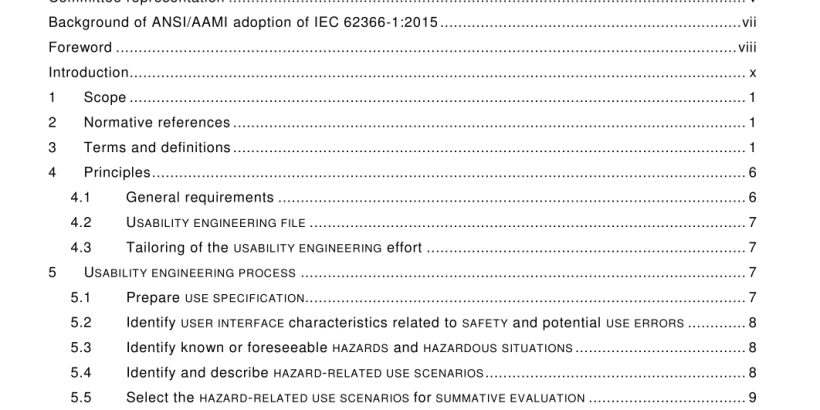ANSI AAMI IEC 62366-1-2015 pdf download
ANSI AAMI IEC 62366-1-2015 pdf download.Medical devices
1 * Scope
This part of IEC 62366 specifies a PROCESS for a MANUFACTURER to analyze, specify, develop and evaluate the USABILITY of a MEDICAL DEVICE as it relates to SAFETY . This USABILITY ENGINEERING ( HUMAN FACTORS ENGINEERING ) PROCESS permits the MANUFACTURER to assess and mitigate RISKS associated with CORRECT USE and USE ERRORS , i.e., NORMAL USE . It can be used to identify but does not assess or mitigate RISKS associated with ABNORMAL USE . NOTE 1 S AFETY is freedom from unacceptable RISK . Unacceptable RISK can arise from USE ERROR , which can lead to exposure to direct physical HAZARDS or loss or degradation of clinical functionality. NOTE 2 Guidance on the application of USABILITY ENGINEERING to MEDICAL DEVICES is available in IEC 62366-2 2 , which addresses not only SAFETY but also aspects of USABILITY not related to SAFETY . If the USABILITY ENGINEERING PROCESS detailed in this International Standard has been complied with, then the USABILITY of a MEDICAL DEVICE as it relates to SAFETY is presumed to be acceptable, unless there is OBJECTIVE EVIDENCE to the contrary. NOTE 3 Such OBJECTIVE EVIDENCE can subsequently originate from POST – PRODUCTION surveillance.
5.2 Identify USER INTERFACE characteristics related to SAFETY and potential USE ERRORS
The MANUFACTURER shall identify USER INTERFACE characteristics that could be related to SAFETY as part of a RISK ANALYSIS performed according to ISO 1 4971 :2007, 4.2. This identification may also be performed using the tools and techniques from the USABILITY ENGINEERING PROCESS . This identification shall include consideration of the PRIMARY OPERATING FUNCTIONS that are provided in applicable particular MEDICAL DEVICE SAFETY standards. NOTE 1 ISO 1 4971 :2007, C.2.29 to C.2.34 provides a list of questions that can be used to identify USER INTERFACE characteristics that could impact SAFETY . The list of questions is not exhaustive. Based on the identified USER INTERFACE characteristics and USE SPECIFICATION , the MANUFACTURER shall identify the USE ERRORS that could occur and are related to the USER INTERFACE . This identification may be accomplished by conducting a TASK analysis. [27][28][29] NOTE 2 T ASK analysis is described in IEC 62366-2. The results of this identification of characteristics related to SAFETY shall be stored in the USABILITY ENGINEERING FILE . Compliance is checked by inspection of the USABILITY ENGINEERING FILE .
Some people use the terms ‘human factors engineering’ and ‘usability engineering’ interchangeably while others draw a distinction between them. Those who draw a distinction refer to the development and application of knowledge about people and USER INTERFACE design as ‘human factors engineering’ (and sometimes just human factors), and refer to USER INTERFACE EVALUATION – principally by means of setting acceptance criteria and conducting USABILITY TESTS – as ‘usability engineering’. Regardless of terminology, effective application of the USABILITY ENGINEERING PROCESS (or the same PROCESS by another name) improves USABILITY . Conversely, ineffective application of the USABILITY ENGINEERING PROCESS , or the lack of USABILITY ENGINEERING altogether, can reduce USABILITY . The central concept is that USABILITY does not normally arise just from the well-intentioned application of common sense in design. Rather, USABILITY is the desirable end-product of applying USABILITY ENGINEERING from the beginning and throughout the MEDICAL DEVICE design PROCESS . For the purposes of this standard, USABILITY ENGINEERING (UE) and HUMAN FACTORS ENGINEERING (HFE) are treated as synonymous.
